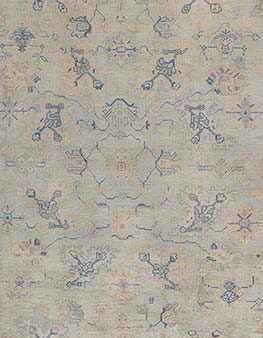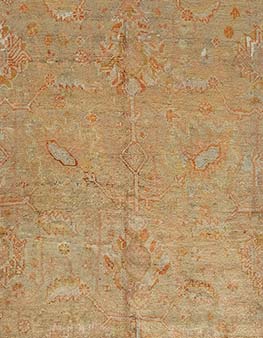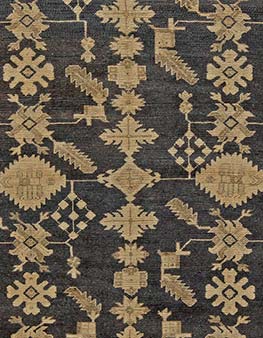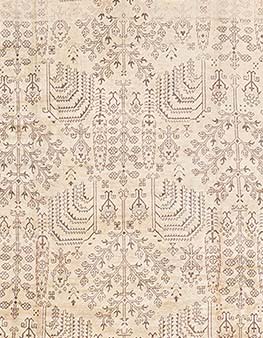An Explanation of Oushak Rugs
Oushak rugs are a subcategory of Turkish rugs. These decorative fabrics originate in Oushak in the west-central Anatolia, today just south of Istanbul, Turkey. You may find them under different spelling – Uşak or Ushak. Oushak rugs belong to one of the oldest and finest Oriental carpets. Therefore, their designs are complex, and colors are warm with a predominance of red and brown. Oushak rugs are usually made with a silky, soft and luminous wool.
Never-Passing Charm of Antique Oushak Rugs
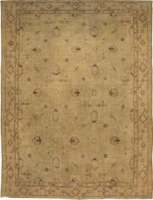 Antique oriental carpets and rugs from Oushak are also known as Ushak. Since the sixteen century, they have been among esteemed objects d’art. Oushak rugs appeared in still life paintings of important European personages. Artists such as Holbein, Lotto, Velasquez, Memling and Vermeer depicted them. Until the eighteenth century the Ottoman carpets were decisively in vogue. They carried unabated designs such as ‘medallion’ and ‘star’ in royal tones of brick red, terracotta, deep blue and gold. Even after that period they have continued to grace European interiors. Over time, designs of Oushak rugs have started to evolve. Yet, they still managed to keep the distinctive character of the 16th century prototypes. Large scale ovoid or star-shaped medallions enclosing split-leaf ‘rumi’ and floral vinery are characteristic motifs.
Antique oriental carpets and rugs from Oushak are also known as Ushak. Since the sixteen century, they have been among esteemed objects d’art. Oushak rugs appeared in still life paintings of important European personages. Artists such as Holbein, Lotto, Velasquez, Memling and Vermeer depicted them. Until the eighteenth century the Ottoman carpets were decisively in vogue. They carried unabated designs such as ‘medallion’ and ‘star’ in royal tones of brick red, terracotta, deep blue and gold. Even after that period they have continued to grace European interiors. Over time, designs of Oushak rugs have started to evolve. Yet, they still managed to keep the distinctive character of the 16th century prototypes. Large scale ovoid or star-shaped medallions enclosing split-leaf ‘rumi’ and floral vinery are characteristic motifs.
Classification of Antique Oushak Rugs
 Oushak rugs (in Turkish known as Uşak Kilimi) are carpets that use a particular set of designs. Uşak is one of the largest cities in Western Anatolia. From the early days of the Ottoman Empire to the dawn of the 20th century, it was a major center of rug production. It still stands among the most important ones in the world. Anatolia literally translates into “land of the rising sun”. Historically, antique Oushak rugs are classified as Anatolian. The level of international popularity reached by the Oushak rugs from Uşak caused an interesting phenomenon. The word “Ushak” became to be considered an English word of Turkic origin. Ushak carpets (vintage Oushak rugs), appeared on Renaissance paintings. It was because they adorned cathedrals and churches. Moreover, the wealthy and powerful always had them in their homes.
Oushak rugs (in Turkish known as Uşak Kilimi) are carpets that use a particular set of designs. Uşak is one of the largest cities in Western Anatolia. From the early days of the Ottoman Empire to the dawn of the 20th century, it was a major center of rug production. It still stands among the most important ones in the world. Anatolia literally translates into “land of the rising sun”. Historically, antique Oushak rugs are classified as Anatolian. The level of international popularity reached by the Oushak rugs from Uşak caused an interesting phenomenon. The word “Ushak” became to be considered an English word of Turkic origin. Ushak carpets (vintage Oushak rugs), appeared on Renaissance paintings. It was because they adorned cathedrals and churches. Moreover, the wealthy and powerful always had them in their homes.
Design of Antique Oushak Rugs
Oushak rugs belong to one of the most significant categories of floor coverings. As all Turkish rugs, Oushak rugs are woven with the application of the symmetrical knot. Ghiordes knot (the symmetric knot) appears mainly in Asia Minor, the Caucasus, Iran (formerly Persia), and Europe. The majority of antique Oushak rugs have relatively loose knots. It gives them a supple body. In turn, silky, high-quality wool provides long and luminous piles. The most popular designs of vintage oushak rugs i.e. ‘star’ and ‘medallion’ originated in Uşak. The dyes tend towards cinnamons, terracotta tints, gold, blues, greens, ivory, saffron and grays. The monumental scale, relaxed structure and playful palette of Turkish antique Oushak rugs makes them unique. Thus, thanks to their qualities, they remain a favorite within the pantheon of decorative antique oriental rugs.






